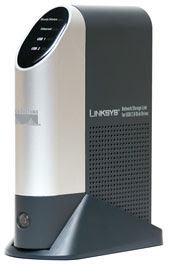Front Panel & Lights
Ready/Status This LED will begin blinking when you turn on the Storage Link. This is the Storage Link running a self-test. When this test has completed, the LED will appear solid green.
An Amber LED indicates an error with the Storage Link.
 Ethernet Green. The Ethernet LED serves two purposes. If the LED is continuously lit, the Network Storage Link is successfully connected to a device through the Ethernet port. A blinking LED indicates network activity.
Ethernet Green. The Ethernet LED serves two purposes. If the LED is continuously lit, the Network Storage Link is successfully connected to a device through the Ethernet port. A blinking LED indicates network activity.
Disk 2 This will light up when a Flash disk or USB hard drive is connected. When the light is blinking slowly, this means the disk or drive can be disconnected. A fast blinking light means data is being transferred over your network.
Disk 1 This will light up when a USB hard drive is connected. A blinking LED indicates network
Activity.
Power Switch The power switch is a "soft switch". If the Storage Link is powered off, you can start it up by briefly pressing the power switch. To power down the Network Storage Link, press the power switch, and wait for it to shutdown and the LEDs to turn off.
Ready/Status This LED will begin blinking when you turn on the Storage Link. This is the Storage Link running a self-test. When this test has completed, the LED will appear solid green.
An Amber LED indicates an error with the Storage Link.
 Ethernet Green. The Ethernet LED serves two purposes. If the LED is continuously lit, the Network Storage Link is successfully connected to a device through the Ethernet port. A blinking LED indicates network activity.
Ethernet Green. The Ethernet LED serves two purposes. If the LED is continuously lit, the Network Storage Link is successfully connected to a device through the Ethernet port. A blinking LED indicates network activity.Disk 2 This will light up when a Flash disk or USB hard drive is connected. When the light is blinking slowly, this means the disk or drive can be disconnected. A fast blinking light means data is being transferred over your network.
Disk 1 This will light up when a USB hard drive is connected. A blinking LED indicates network
Activity.
Power Switch The power switch is a "soft switch". If the Storage Link is powered off, you can start it up by briefly pressing the power switch. To power down the Network Storage Link, press the power switch, and wait for it to shutdown and the LEDs to turn off.


